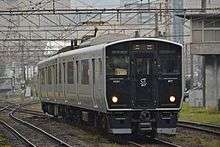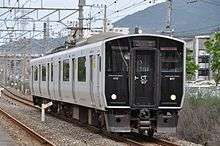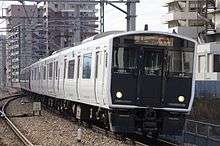817 series
The 817 series (817系) is an AC electric multiple unit (EMU) train type operated on commuter and local services by Kyushu Railway Company (JR Kyushu) in Japan since 2001. The design was based on the earlier 815 series, with transverse seating replacing the previous longitudinal seating,[2] although later variants reverted to longitudinal seating.
| 817 series | |
|---|---|
 Nagasaki-based 817-0 series set V029 in October 2011 | |
| Manufacturer | Hitachi |
| Family name | Hitachi A-train |
| Replaced | 457 series, 475 series, 717 series |
| Constructed | 2001–2015 |
| Entered service | October 2001 |
| Number built | 145 vehicles (67 sets) |
| Number in service | 145 vehicles (67 sets) |
| Formation | 2/3 cars per trainset |
| Fleet numbers | V001-V031, V101-114, V1101-1104, V2001-2007, V3000-3011 |
| Operator(s) | JR Kyushu |
| Depot(s) | Kagoshima, Kumamoto, Minami-Fukuoka, Nagasaki, Nōgata |
| Specifications | |
| Car body construction | Aluminium |
| Car length | 20,000 mm (65 ft 7 in) |
| Width | 2,994 mm (9 ft 9.9 in) |
| Height | 4,096 mm (13 ft 5.3 in) |
| Floor height | 1,115 mm (3 ft 7.9 in)[1] |
| Doors | 3 pairs per side |
| Maximum speed | 120 km/h (75 mph)[2] |
| Electric system(s) | 20 kV AC 60 Hz |
| Current collection method | Overhead catenary |
| Multiple working | 811/813/815 series |
| Track gauge | 1,067 mm (3 ft 6 in) |
Variants
There are five sub-series variants, 817-0, 817-1000, 817-1100, 817-2000, and 817-3000 series, allocated to five depots, Kagoshima, Kumamoto, Minami-Fukuoka, Nagasaki, and Nōgata. The trains carry large colour-coded stickers next to the passenger doors according to the depot.[3][4]
- Kagoshima (817-0 series): Blue
- Kumamoto (817-0 series): Green
- Minami-Fukuoka (817-3000 series): Orange
- Nagasaki (817-0 series): Red
- Nōgata (817-1000, 817-1100, 817-2000 series): Yellow
817-0 series

31 two-car sets (V001 to V031) were delivered to Minami-Fukuoka and Nōgata depots between August September 2001 for use on the newly electrified Fukuhoku Yutaka Line, Nagasaki Main Line, and Sasebo Line.[1]
The 31 sets were later reallocated to Kagoshima, Kumamoto, and Nagasaki depots from 2003 following the arrival of 817-1000 series sets.[3]
Formation
| Numbering | KuMoHa 817 | KuHa 816 |
|---|---|---|
| Capacity total/seated |
131/50 | 127/40 |
The KuMoHa 817 car is fitted with a PS401K single-arm pantograph.[5]
 KuHa 816-13 of Kumamoto-based set V013 in December 2007
KuHa 816-13 of Kumamoto-based set V013 in December 2007 KuMoHa 817-13 of Kumamoto-based set V013 in December 2007
KuMoHa 817-13 of Kumamoto-based set V013 in December 2007
Interior
Seating is arranged in a transverse configuration, with flip-over seat backs to face the direction of travel. The KuHa 816 car has a toilet and a wheelchair space.[5]
 Interior view
Interior view
817-1000 series

12 second-batch 817-1000 series two-car sets (V101 to V112) were delivered to Nōgata depot between August and September 2003, displacing the earlier 817-0 series sets based there. These sets were designed to be able to be lengthened easily to three-cars sets in the future if needed.[3] A further two third-batch sets (V113 and V114) were added in February 2005.[5]
Formation
| Numbering | KuMoHa 817-1000 | KuHa 816-1000 |
|---|---|---|
| Capacity total/seated |
131/50 | 127/40 |
The KuMoHa 817 car is fitted with a PS401K single-arm pantograph.[5]
Interior
As with the 817-0 series, seating is arranged in a transverse configuration, with flip-over seat backs to face the direction of travel. The KuHa 816 car has a toilet and a wheelchair space.[5]
Experimental battery EMU set
In March 2013, JR Kyushu converted two-car 817-1000 series set VG114 to a battery electric multiple unit (BEMU) by adding lithium-ion storage batteries to enable the train to run on non-electrified lines.[6] The train has a maximum speed of 120 km/h (75 mph) when running off the 20 kV AC overhead power supply of electrified lines, and 80 km/h (50 mph) when running on battery power over non-electrified lines.[6] It can run a distance of up to 30 km (20 mi) on battery power.[6] The train was tested on non-electrified lines from September 2013.[7]
817-1100 series
Four fourth-batch two-car 817-1100 series sets (V1101 to V1104) were delivered to Nōgata depot in March 2007 to provide increased capacity on the Fukuhoku Yutaka Line. These were based on the earlier 817-1000 series, but with larger LED destination indicators on the cab ends.[3]
817-2000 series
Six fifth-batch 817-2000 series two-car sets (V2001 to V2006) were delivered to Nōgata Depot from January 2012 for introduction on the Fukuhoku Yutaka Line from the start of the revised timetable on 17 March 2012.[4][9] These sets have white-painted bodysides, and feature longitudinal seating to provide increased overall capacity and relieve overcrowding on the line. These sets feature interior LED lighting. They operate at a maximum speed of 100 km/h, although they have a maximum design speed of 120 km/h.[4] A seventh set, V2007, was delivered in February 2013.[10]
Formation
As of 1 October 2017, the fleet consists of seven two-car 817-2000 sets (V2001 to V2007), all based at Nōgata Depot, and formed as shown below.[10]
| Designation | Mc | Tc |
|---|---|---|
| Numbering | KuMoHa 817-2000 | KuHa 816-2000 |
| Weight (t) | 35.2 | 28.0 |
| Capacity total/seated |
137/48 | 130/40 |
The KuMoHa 817 car is fitted with a PS401K single-arm pantograph. The KuHa 816 car has a toilet.[4]
817-3000 series

Five fifth-batch 817-3000 series three-car sets (V3001 to V3005) were delivered to Minami-Fukuoka depot from January 2012 for introduction on the Fukuhoku Yutaka Line from the start of the revised timetable on 17 March 2012.[4][9] As with the 817-2000 series, these sets have white-painted bodysides, and feature longitudinal seating to provide increased overall capacity and relieve overcrowding on the line. These sets feature interior LED lighting.[4] Four more sets, V3006 to V3009, were delivered in February 2013.[10]
Formation
As of 1 October 2017, the fleet consists of 11 three-car 817-3000 sets (V3001 to V3011), all based at Minami-Fukuoka Depot, and formed as shown below.[8]
| Designation | Tc | M | T'c |
|---|---|---|---|
| Numbering | KuHa 817-3000 | MoHa 817-3000 | KuHa 816-3000 |
| Weight (t) | 28.0 | 34.0 | 27.8 |
| Capacity total/seated |
130/40 | 152/56 | 137/48 |
The MoHa 817 car is fitted with a PS401K single-arm pantograph. The KuHa 817 car has a toilet.[4]
Interior
 Interior view
Interior view Wooden longitudinal seating
Wooden longitudinal seating Toilet
Toilet
References
- JR電車編成表 '02夏号 [JR EMU Formations - Summer '02]. Japan: JRR. June 2002. ISBN 978-4-88283-037-5.
- Jēāru zensharyō handobukku: Rail Magazine 2009 JR全車輌ハンドブック2009 [JR Rolling Stock Handbook 2009]. Japan: Neko Publishing. 2009. ISBN 978-4-7770-0836-0.
- 813・815・817系の番台別特徴と輸送形態 [813/815/817 series subclass differences and operation details]. Japan Railfan Magazine. 50 (585): 56–61. January 2010.
- 817系2000・3000番台 [817-2000/3000 series]. Japan Railfan Magazine. 52 (613): 55–57. May 2012.
- JR電車編成表 2010夏 [JR EMU Formations - Summer 2010]. Japan: Kotsu Shimbunsha. May 2010. ISBN 978-4-330-14310-1.
- JR九州 電池で走る電車、実証試験へ ローカル線の体質改善に期待 [JR Kyushu to test train running on batteries - hopes to improve local line service quality]. MSN Sankei News (in Japanese). Japan: The Sankei Shimbun & Sankei Digital. 20 March 2013. Archived from the original on 16 September 2013. Retrieved 11 September 2013.
- 817系蓄電池車両が日田彦山線で試運転 [817 series battery unit test run on Hitahiko Line]. Japan Railfan Magazine Online (in Japanese). Japan: Koyusha Co., Ltd. 10 September 2013. Retrieved 11 September 2013.
- Jr電車編成表 2018冬 JR電車編成表 2018冬 [JR EMU Formations - Winter 2018] (in Japanese). Japan: Kotsu Shimbunsha. 15 November 2017. p. 218–220. ISBN 978-4-330-84117-5.
- 甲種鉄道車両輸送計画表 [Train Delivery Schedule]. Tetsudō Daiya Jōhō Magazine. 41 (334): 125. February 2012.
- JR電車編成表 2013夏 [JR EMU Formations - Summer 2013]. Japan: Kotsu Shimbunsha. May 2013. pp. 216–218. ISBN 978-4-330-37313-3.
